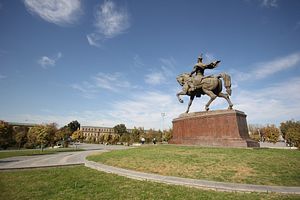Kazakhstan and Uzbekistan plan to introduce a common visa. The new visa, dubbed the “Silk Visa” is in the final stages of preparation and will enable foreigners with a valid visa from either country to travel in both countries.
The idea behind the creation of the common visa was put forward last summer by Dariga Nazarbayeva, the daughter of the president of Kazakhstan and also the chairwoman of the Kazakh Senate’s Committee on Foreign Relations, Defense, and Security. Calling it the “Asian Schengen,” she emphasized that the common visa would increase trust between the governments of Kazakhstan and Uzbekistan and boost the tourism potential of both countries. In June 2018, Nazarbayeva said, “For tourists from Europe and Southeast Asia, Central Asia is not geographically near. When they come to the region, they want to see all the countries and all the sights in one trip. Therefore, there is a need to create a common visa.”
In December 2018, the first deputy chairman of the State Committee for Tourism of Uzbekistan, Ulugbek Kasymhodzhaev, said that the “Silk Visa” project had passed all approvals in the departments of the two states and only technical details and equipment remained to be discussed. Presumably, the visa will be launched in February 2019.
Kasymhodzhaev also noted that the authorities of Tajikistan and Kyrgyzstan had expressed interest in joining the common visa project. At the same time, Kazakhstan is interested in extending an invitation to Azerbaijan and Turkey.
The new Silk Visa is part of a broader trend in the region. Over the last several years, Central Asian countries have significantly liberalized their visa regimes with the rest of the world to attract more tourists.
Since 2017, citizens of 45 countries, including member-states of the Organization for Economic Cooperation and Development (OECD) and the European Union, have been able to travel to Kazakhstan visa-free for 30 days. As a result, in 2017 alone, Kazakhstan saw almost an 18 percent increase in tourists, achieving a record of 5.8 million foreign visitors in the first nine months of the year. Low numbers of tourists, as evidenced by a mere 200,000 in 2014, similarly encouraged the government of Tajikistan to reconsider its visa regime. In part by shifting from paper to online visa applications, Tajikistan was able to attract 900,000 tourists in the first six months of 2018.
Following Karimov’s death in 2016, Uzbekistan, under the leadership of President Shavkat Mirziyoyev, also became much more open to the rest of the world. In February 2018, the Uzbek government adopted a visa-free regime with seven new countries, including Israel, Indonesia, South Korea, Malaysia, Singapore, Turkey, and Japan. Later that same year, Tashkent introduced an electronic visa system and put in place simplified visa procedures for citizens of 39 other countries. Consequently, the number of tourists rose from 2.2 million in the first nine months of 2016 to 4.4 million in the same period in 2018. In January 2019, Mirziyoyev announced that citizens of 45 countries (excluding the United States, China, India, and others) will not need a visa to travel to Uzbekistan.
In contrast to its neighbors in the region, Turkmenistan lags behind in this regard. The country remains closed to citizens of other Central Asian states, let alone Americans or Europeans. As a result, tourism in Turkmenistan remains a largely undeveloped sector with fewer than 10,000 tourists visiting every year.
In 2017, the direct contribution of tourism to the combined GDP of Central Asian countries was $3.4 billion, which accounted for approximately 2 percent of the total GDP. Therefore, there is much room for the tourism industry to expand, which would bring more cash and more jobs to the countries and their economies.
According to a recent TripAdvisor survey, 47 percent of travelers responded that a single visa regime in Central Asia would increase their willingness to travel to the region. From this perspective, the Silk Visa is a laudable step in the right direction.
However, visas are not the only the obstacle for the development of tourism in the region. Connectivity and security are also serious impediments. Central Asian countries are far from being well connected in terms of train or air routes. In fact, there are more frequent flights between Central Asian countries and Russia, China, and Turkey than between neighboring countries in the region. Regular flights between Tashkent and Dushanbe resumed only in April 2017 after almost 25 years, and Astana was connected to Dushanbe by air only in December 2018. However, in both cases, connections remain limited with only one flight per week. Flights from Bishkek to Tashkent, Dushanbe, and Astana are fewer than three per week. From a security perspective, Central Asia’s geographical proximity to Afghanistan raise safety concerns for visitors. Moreover, flashes of violence in Kazakhstan, such as the Aktobe and Almaty attacks in 2016, and the murder of four tourists last summer in Tajikistan have further exacerbated the perception of Central Asia as a dangerous tourist destination. Therefore, if the governments of Central Asia are serious about developing tourism in the region, they would be smart not only to expand visa-free regimes but also to invest more heavily in connectivity and security.
Khamza Sharifzoda is a graduate student at Georgetown University. He specializes in the politics and governance of Russia, Turkey, and Eurasia.

































